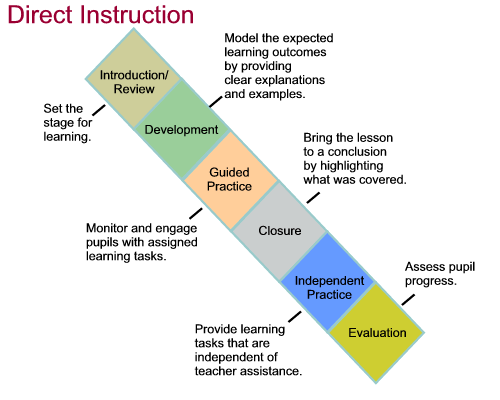Monday, September 27, 2010
From Short to Long....Memory That Is
Automaticity was a word that I wasn't too sure of. Direct Instruction and automaticity go hand in hand. After drilling and practicing with the students, their basic knowledge becomes automatic, like multiplication tables for instance. The meaning of the word automaticity has crossed over from my short term memory to my long term memory and now when I am asked what it means, the definition is automatic!!
Sunday, September 19, 2010
Direct Instruction

In assessing my skills for using the Direct Instruction strategy, I find that I understand the planning of the tasks, and the methods for performing the instructional tasks. I feel that it may be difficult to create post-instructional tasks, like designing independent practice. I think I could create challenging assessment tools, self-directed questions, and give insightful reflections. I think it will all come easier once I have designed and created a lesson and know its direction and expected outcomes.
Wednesday, September 15, 2010
A Bit More Comfortable Now
After all the review of the models, strategies, objectives, lessons, planning and Bloom's Taxonomy, I feel a bit more comfortable. It helped me a great deal to "refresh" these concepts because they are the basis for teaching. I think the part that helped me the most was having the triangles as visuals. It is easy to see how all the concepts are interrelated.
Friday, September 10, 2010
A - G - O
Aims, Goals & Objectives
Aims are general statements about general learning outcomes.
Goals are statements of educational intention. They are more specific than aims and goals adjust to the theme of your unit.
Objectives are specific statements which describe the student's behavior and the measurable outcomes to be achieved.
The sources for formulating aims, goals and objectives are as follows: aims - NYS Standards, goals - State Standards, objectives - teacher formulated.
Bloom's Taxonomy helps you write objectives because it organizes thinking skills into six levels. By using the terms (verbs) in Bloom's Taxonomy, the learner is enabled to reach higher-order thinking.
In order to teach and have the students learn, the teacher must create conditions for the student's independent learning. A student and teacher enter from two different directions and they each bring their skills and strategies. The student brings their ability to cope and process their abilities. A learner must take the acquired information, process it, understand it and store it to use or draw from successfully again. Teaching can be described as giving knowledge or skills through creative learning activities.
Aims are general statements about general learning outcomes.
Goals are statements of educational intention. They are more specific than aims and goals adjust to the theme of your unit.
Objectives are specific statements which describe the student's behavior and the measurable outcomes to be achieved.
The sources for formulating aims, goals and objectives are as follows: aims - NYS Standards, goals - State Standards, objectives - teacher formulated.
Bloom's Taxonomy helps you write objectives because it organizes thinking skills into six levels. By using the terms (verbs) in Bloom's Taxonomy, the learner is enabled to reach higher-order thinking.
In order to teach and have the students learn, the teacher must create conditions for the student's independent learning. A student and teacher enter from two different directions and they each bring their skills and strategies. The student brings their ability to cope and process their abilities. A learner must take the acquired information, process it, understand it and store it to use or draw from successfully again. Teaching can be described as giving knowledge or skills through creative learning activities.
Reviewing Models, Strategies & Methods
Models are general broad approaches to teaching. The instructional models are information processing, behavioral, social interaction and personal. There are many goals that go along with each model. For example, the behavioral model helps develop basic skills and knowledge while the information processing model equips students with knowledge, how to find it, use it and reflect on it.
The strategies throughout the models are a set of steps that a teacher follows in order to implement or achieve the learning objectives. The instructional strategies that can be implemented are: direct, indirect, interactive, experimental and independent study.
Methods such as lecture, debate, and inquiry are used to reach the most specific goals of instruction. A teacher's method is the most individual way to create a positive learning environment in his/her classroom.
The strategies throughout the models are a set of steps that a teacher follows in order to implement or achieve the learning objectives. The instructional strategies that can be implemented are: direct, indirect, interactive, experimental and independent study.
Methods such as lecture, debate, and inquiry are used to reach the most specific goals of instruction. A teacher's method is the most individual way to create a positive learning environment in his/her classroom.
Wednesday, September 8, 2010
General Methods of Instruction begins!!!!
I'm back and ready to begin on another adventure in learning. This Fall I am taking General Methods and Research in Literacy.
Subscribe to:
Comments (Atom)